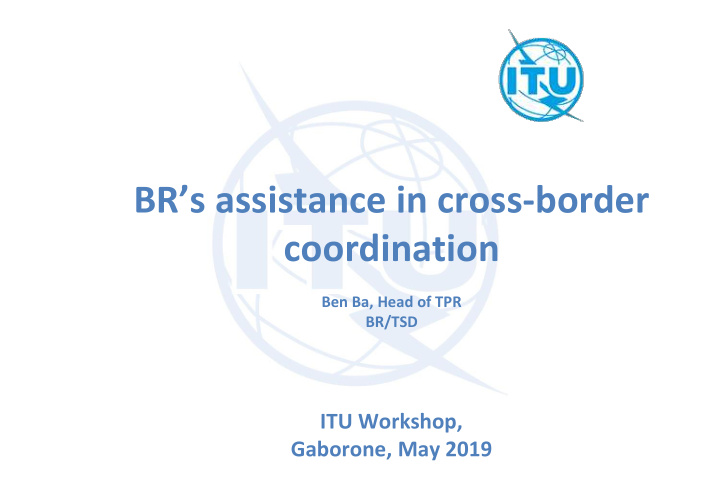



BR’s assistance in cross -border coordination Ben Ba, Head of TPR BR/TSD ITU Workshop, Gaborone, May 2019
Overview Regulatory framework BR’s assistance for harmful interference BR’s assistance for frequency coordination
Main regulatory instruments Radio Regional Special Regulations Agreements Agreements • Allocations • Regional plans • Between countries • Procedures • Plan modification • within other • Technical limits procedures international • Worldwide organizations • Technical basis Plans Outside ITU Maintained by ITU Other ITU instruments: Rules of Procedure ITU-R Recommendations
Approaches to sharing spectrum Approaches Frequency Coordination Frequency Planning • coordination of frequencies with • Distribution of frequencies neighbours prior to bringing between countries/stations station in operation • Aims at equitable access to • Based on real and actual needs in spectrum frequencies • Satisfies long term needs of • Flexible and efficient spectrum countries in frequencies use • Sometimes not ideal for efficient • RR Article 9 – international spectrum use coordination procedures
BR’s assistance In the application of the procedures of the RR and Regional Agreements, training in the related software In resolving harmful interference and infringement In transition to digital TV and Digital Dividend In multilateral coordination meeting, e.g. on spillover Providing best practices of spectrum usage
Assistance in a case of harmful interference Cooperation between administrations Direct contact between monitoring stations or operators If necessary, inform the BR If bilateral action failed, request BR assistance The BR may request the cooperation of stations on the International Monitoring List If the interference persists, the BR prepares a report to the RRB
Harmful interference statistics > 1000 Appendix 10 Reports in 2018 1079 broadcasting 17 land mobile 13 aeronautical mobile 2 fixed 2 amateur 1 maritime mobile
R eronautica o i e route ser ice B Broadcastin ser ice and o i e ser ice ariti e o i e ser ice
Harmful interference Any assignment that could cause harmful interference shall be notified Spectrum monitoring Coordinate with your neighbours Procedure for resolving interference in coordination agreements
Assistance for DSO in Sub-Saharan Africa Digital migration and spectrum Policy summits December 2011: Nairobi September 2012: Accra Decisions Adoption of the MPEG4 and DVB-T Adoption of the dual HDTV/SD for the set-top boxes
Objectives of the frequency coordination activities To assist the countries in coordinating the modifications of the GE06D Plan in the band 470-694 MHz To enable the administrations to successfully to put in operation the broadcasting and mobile services in the UHF band without harmful interference
Results: 1st and last iterations Iteration 1, percentage of assigned channels 100.00 80.00 60.00 40.00 20.00 0.00 Iteration 33- Nairobi-2 100.00 50.00 0.00 AFS BEN CME COG CPV GAB GNB GUI MDG NGR SEN STP TCD ZMB CTI TZA GHA UGA BFA SDN KEN SSD ZWE BOT Percentage Assignable/submitted
BR actions Provided the necessary software and tools Workshops and training on the GE06 tools and frequency planning Assistance in sub-regional coordination meetings
Assistance to ASMG and CAC 2014-2015: Frequency Coordination Meetings for Arab Spectrum Management Group (ASMG) 2017-2018: Frequency Coordination for Central America and Caribbean (CAC)
Thank you!
Recommend
More recommend